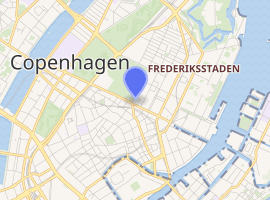Kronprinsessegade 6
Kronprinsessegade 6 is a Neoclassical property overlooking Rosenborg Castle Garden in central Copenhagen, Denmark.
| Kronprinsessegade 6 | |
|---|---|
.jpg) | |

| |
| General information | |
| Location | Copenhagen |
| Country | Denmark |
| Coordinates | 55°40′58.89″N 12°34′52.37″E |
| Completed | 1804 |
| Design and construction | |
| Architect | Johan Martin-Quist |
History
Kronprinsessegade 6 was built in 1803-1804 by master builder Johan martin Quist.[1]
C. Olufsen (1764-1827), professor of agriculture, lived in the building in 1811–12. N. Clausen (1793-1877) lived in the building from its completion in 1840–41. The physician Knud Faber (1862-1956) lived in the ground floor from 1846 until his death ten years later.
In the 1920s, Kronprinsessegade 6 housed the embassy of the Soviet Union. Knud Erichsen, a wholesale company in the sugar industry, was in 1950 based in the building.[2]
Architecture
Quist's original building consisted of three storeys over a high cellar. The fourth storey was not added until 1896. The gate opens to a small courtyard. A three-storey side wing extends from the rear side of the building along the northside of the courtyard to a three-storey cross wing with gateway that opens to another courtyard. The building was listed on the Danish registry of protected buildings and places in 1945.
Today
Today a part of the building is used as offices for the film company Citizen Dane, that have furnished and decorated the rooms in a consistent old style..
Citizen Dane is a market leader in Denmark within corporate movies.
References
- "Kronprinsessegade 6". indenforvoldene.dk (in Danish). Retrieved 5 August 2018.
- "Danmarks ældste forretninger 1100-1911" (PDF). Kraks Forlag (in Danish). Retrieved 16 February 2020.
External links
| Wikimedia Commons has media related to Kronprinsessegade 6. |